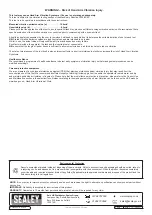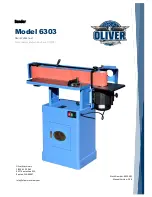
2. INTRODUCTION
Lightweight aluminium body with moulded handle reducing chill effects and providing added control. Fitted with directional, low noise 360° air
exhaust and air control valve. Supplied with Ø150mm hook-and-loop pad and adjustment spanner.
3. SPECIFICATION
4. PREPARATION
Model No:
. . . . . . . . . . . . . . . . . . . . . . . . . . . . . . . . . . . . . . . . . . . . . . . . . . . . .
GSA07
Pad Size: . . . . . . . . . . . . . . . . . . . . . . . . . . . . . . . . . . . . . . . . . . . . . . . . . . . . . Ø150mm
Thread Size: . . . . . . . . . . . . . . . . . . . . . . . . . . . . . . . . . . . . . . . . . . . . . . . . . . .5/16"UNF
Free Speed: . . . . . . . . . . . . . . . . . . . . . . . . . . . . . . . . . . . . . . . . . . . . . . . . . . 10000rpm
Orbit Size:. . . . . . . . . . . . . . . . . . . . . . . . . . . . . . . . . . . . . . . . . . . . . . . . . . . . . . . Ø5mm
Air Consumption: . . . . . . . . . . . . . . . . . . . . . . . . . . . . . . . . . . . . . . . . . . . . . . . . . . 4cfm
Operating Pressure: . . . . . . . . . . . . . . . . . . . . . . . . . . . . . . . . . . . . . . . . . . . . . . . . 90psi
Air Inlet Size: . . . . . . . . . . . . . . . . . . . . . . . . . . . . . . . . . . . . . . . . . . . . . . . . . . .1/4"BSP
Weight: . . . . . . . . . . . . . . . . . . . . . . . . . . . . . . . . . . . . . . . . . . . . . . . . . . . . . . . . . . 1.8kg
Noise Power/Pressure:. . . . . . . . . . . . . . . . . . . . . . . . . . . . . . . . . . . . . . . . 107/96dB(A)
Vibration/Uncertainty: . . . . . . . . . . . . . . . . . . . . . . . . . . . . . . . . . . . . . . . . . 15.8/6.3m/s²
4.1. Air Supply
4.1.1. Ensure the sander air valve (or throttle) is in the "off" position before connecting to the air supply.
4.1.2. You will require an air pressure between 70-90psi, and an air flow according to the specification above.
4.1.3.
p
WARNING!
Ensure the air supply is clean and does not exceed 90psi while operating the sander. Too high an air pressure and unclean
air will shorten the product life due to excessive wear, and may be dangerous causing damage and/or personal injury.
4.1.4. Drain the air tank daily. Water in the air line will damage the sander
and will invalidate your warranty.
4.1.5. Clean air inlet filter weekly. Recommended hook-up procedure is shown in fig 1.
4.1.6. Line pressure should be increased to compensate for unusually long air hoses (over 8 metres). The minimum hose diameter should be 1/4”
I.D. and fittings must have the same inside dimensions.
4.1.7. Keep hose away from heat, oil and sharp edges. Check hoses for wear, and make certain that all connections are secure.
4.2. Couplings.
Vibration may cause failure if a quick change coupling is connected directly to the air sander. To overcome this, connect a leader hose to
the sander. A quick change coupling may then be used to connect the leader hose to the air line recoil hose. See fig 1 & 2.
fig.1
fig.2
5. OPERATION
p
WARNING! Ensure you read, understand and apply safety instructions for use.
5.1. Assembly.
5.1.1 Screw in the backing pad into the spindle nut (fig 3). Tighten using the supplied spanner.
5.1.2. Apply the appropriate sanding pad to the backing pad. Use only pads with speed ratings equal to or higher than the speed rating of the sander.
DO NOT
use
cloth backed sanding pads.
5.1.3. Connect the air supply to sander and press the trigger and check that the sander is working correctly.
5.1.4. The air flow may be regulated by turning the air control valve on the side of the handle (fig 3).
5.2. Operating.
5.2.1. Always use a sanding pad appropriate for the job.
5.2.2. Work progressively from coarse grades to finer grades.
7
DO NOT
go from coarse to fine in one step as it may be difficult to remove
swirl marks left by the coarser grit.
7
DO NOT
apply excessive pressure, let the sander do the work for you.
5.2.3. Start the sander and bring the sanding disc to the work surface evenly and slowly.
Move the sander back and forth in overlapping areas.
5.2.4. Remove the sanding disc from the work surface before stopping the sander.
Regularly check the sanding pad for wear, always change a cracked or damaged pad.
7
DO NOT
allow the sander to run in idle for an extended period of time as this will shorten
the life of the bearings.
fig.3
6. MAINTENANCE
p
WARNING!
Disconnect sander from air supply before changing accessories, servicing or performing maintenance.
Replace or repair
damaged parts.
Use genuine parts only. Non-genuine parts may be dangerous and will invalidate the warranty.
6.1.
Lubricate the air sander daily with a few drops of good grade air tool oil such as Sealey ATO/500 or ATO1000, dripped into the air inlet
before use.
6.2.
Clean the sander after use and change pads when required.
6.3.
Loss of power or erratic action may be due to the following:
a)
Excessive drain on the air line. Moisture or restriction in the air pipe. Incorrect size or type of hose connectors. To remedy check the air
supply and follow instructions in section 4.
b)
Grit or gum deposits in the sander may also reduce performance. If your model has an air strainer (located in the area of the air inlet),
remove the strainer and clean it. Flush the sander out with gum solvent oil or an equal mixture of SAE No 10 oil and kerosene. Allow to
dry before use.
If you continue to experience problems, contact your local Sealey service agent.
6.4.
For a full service contact your local Sealey service agent.
6.5.
When not in use, disconnect from air supply, clean sander and store in a safe, dry, childproof location.
GSA07 Issue: 2 (L) - 28/03/17
Original Language Version
© Jack Sealey Limited





















